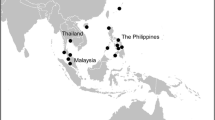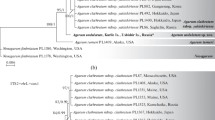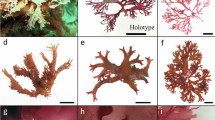Abstract
In the past two decades, many studies have focused on the classification within genus Laminaria, ultimately trying to divide it into two subgroups or genera: Laminaria and Saccharina. A significant debate still surrounds the question of its division, as the conflicting phylogenetic hypotheses that have resulted from the classification studies are based on different taxon sampling, molecular markers, or analysis methods. It is aimed at elucidate the molecular phylogeny within Laminaria and Saccharina. The nine species of Laminariales are sampled from northern Asia and Europe, and 23 new sequences in the nuclear, plastid, and mitochondrial genomes are determined to identify their taxonomic status. The phylogenetic analyses of 71 species are performed, including representatives from six of the seven families of the order Laminariales, based on three separate data sets. An evidence is provided to strongly support a clear split that maintains the two recognized genera, Laminaria and Saccharina, with Laminaria appearing to be the ancestor group. Further, analyses indicate that all taxa in Saccharina and Laminaria did not form a monophyletic lineage, instead Laminariaceae and Lessoniaceae grouped together interlacedly, and Costariaceae appeared as the sister taxon of the Lessoniaceae-Laminariaceae clade. In the phylogenetic analysis, mitochondrial c oxidase I (COI) sequences appeared to be the most credible molecular marker which was more befitting than nuclear encoded internal transcribed spacer (ITS) and plastid encoded rbcL for establishment of Laminariales systematics. It is the most comprehensive phylogeny of the order Laminariales, and contributes to an enhanced understanding and estimation of the phylogenetic relationships for the economically important seaweeds, Laminaria and Saccharina.
Similar content being viewed by others
References
Balakirev E S, Krupnova T N, Ayala F J. 2012. DNA variation in the phenotypicallydiverse brown alga Saccharina japonica. BMC Plant Biol, 12: 108
Bartsch I, Wiencke C, Bischof K, et al. 2008. The genus Laminaria sensu lato: recent insights and developments. Eur J Phycol, 43: 1–8
Bittner L, Payri C E, Couloux A, et al. 2008. Molecular phylogeny of the Dictyotales and their position within the brown algae, based on nuclear, plastidial and mitochondrial sequence data. Mol Phylogenet Evol, 49: 211–226
Bold H C, Wynne M J. 1985. Introduction to the Algae. Ed. 2. Engelwood Cliffs: Prentice Hall Inc
Bolton J J, Germann I, Lüning K. 1983. Hybridization between Atlantic and Pacific representatives of the Simplices section of Laminaria (Phaeophyta). Phycologia, 22: 133–140
Boo S M, Lee W J, Yoon H S, et al. 1999. Molecular phylogeny of Laminariales (Phaeophyceae) inferred from small subunit ribosomal DNA sequences. Phycol Res, 47: 109–114
Brocks J J, Logan G A, Buick R, et al. 1999. Archean molecular fossils and the early rise of eukaryotes. Science, 285: 1033–1036
Chapman A R O. 1975. Inheritance of mucilage canals in Laminaria in eastern Canada. Br Phycol J, 10: 219–223
Cho G Y, Lee S H, Boo S M. 2004. A new brown algal order, Ishigeales (Phaeophyceae), established on the basis of plastid proteincoding rbcL, psaA, and psbA region comparisons. J Phycol, 40: 921–936
Dieck I T. 1992. North Pacific and North Atlantic digitate Laminaria species (Phaeophyta): hybridization experiments and temperature responses. Phycologia, 31: 147–163
Dieck I T, Oliveira E C. 1993. The section Digitatae of the genus Laminaria (Phaeophyta) in the northern and southern Atlantic: crossing experiments and temperature responses. Mar Biol, 115: 151–160
Draisma S G A, Prud’homme van Reine W F, Stam W T, et al. 2001. A reassessment of phylogenetic relationships within the Phaeophyceae based on rubisco large subunit and ribosomal DNA sequences. J Phycol, 37: 586–603
Druehl L D, Collins J D, Lane C E, et al. 2005. An evaluation of methods used to assess intergeneric hybridization in kelp using Pacific Laminariales (Phaeophyceae). J Phycol, 41: 250–262
Druehl L D, Mayes C, Tan I H, et al. 1997. Molecular and morphological phylogenies of kelp and associated brown algae. Plant Syst Evol, 11(Suppl.): 221–235
Druehl L D, Saunders G W. 1992. Molecular explorations in kelp evolution. Prog Phycol Res, 8: 47–83
Erting L, Daugbjerg N, Pedersen P M. 2004. Nucleotide diversity within and between four species of Laminaria (Phaeophyceae) analysed using partial LSU and ITS rDNA sequences and AFLP. Eur J Phycol, 39: 243–256
Funano T. 1980. Crossing experiments between several species of Laminaria in Hokkaido. Hokusuishi-Geppo, 37: 181–207
Graham L E, Wilcox L W. 1999. Algae. Englewood Cliffs: Prentice Hall Inc
Gray M W, Burger G, Lang B F. 1999. Mitochondrial evolution. Science, 5; 283(5407): 1476–81
Kain J M. 1979. A view of the genus Laminaria. Ann Rev Oceanogr Mar Biol, 17: 101–161
Kawai H, Hanyuda T, Draisma S G A, et al. 2007. Molecular phylogeny of Discosporangium mesarthrocarpum (Phaeophyceae) with a reinstatement of the order Discosporangiales. J Phycol, 43: 186–194
Lamouroux J V. 1813. Essai sur les genres de la famille des thalassiophytes non articuleés. Ann Mus Hist Nat, 20: 21–47, 115–39, 267–93, Plates 7–13
Lane C E, Mayes C, Druehl L D, et al. 2006. A multi-gene molecular investigation of the kelp (Laminariales, Phaeophyceae) resolves competing phylogenetic hypotheses and supports substantial taxonomic re-organization. J Phycol, 42: 493–512
Leister D, Kleine T. 2011. Role of intercompartmental DNA transfer in producing genetic diversity. Int Rev Cell Mol Biol, 291: 73–114
Liechtenstein C, Draper J. 1985. Genetic Engineering of Plants. Oxford: Oxford IRL Press
Lüning K. 1979. Growth strategies of three Laminaria species (Phaeophyceae) inhabiting different depth zones in the sublittoral region of Helgoland (North Sea). Mar Ecol Prog Ser, 1: 195–207
Nagai M. 1940. Marine algae of the Kurile Islands. J Fac Agric Hokkaido Imp Univ, 46: 1–310
Oudot-LeSecq M P, Kloareg B, Loiseaux-de Goër S. 2002. The mitochondrial genome of the brown alga Laminaria digitata: a comparative analysis. Eur J Phycol, 37: 163–172
Page R D. 1996. TREEVIEW: an application to display phylogenetic trees on personal computers. Computer Applications in the Biosciences, 12: 357–358
Phillips N, Burrowes R, Rousseau F, et al. 2008. Resolving evolutionary relationships among the brown algae using chloroplast and nuclear genes. J Phycol, 44: 394–405
Posada D, Crandall K A. 1998. MODELTEST: testing the model of DNA substitution. Bioinformatics, 14: 817–818
Raven J A, Allen J F. 2003. Genomics and chloroplast evolution: what did cyanobacteria do for plants? Genome Biol, 4(3): 209
Ronquist F, Huelsenbeck J P. 2003. Mrbayes 3: Bayesian phylogenetic inference under mixed models. Bioinformatics, 19: 1572–1574
Saunders G W, Druehl L D. 1992. Nucleotide sequences of the small subunit ribosomal RNA genes from selected Laminariales (Phaeophyta): implications for kelp evolution. J Phycol, 28: 544–549
Saunders G W, Druehl L D. 1993. Revision of the kelp family Alariaceae and the taxonomic affinities of Lessoniopsis Reinke (Laminariales, Phaeophyta). Hydrobiologia, 260/261: 689–697
Silberfeld T, Leigh J W, Verbruggen H, et al. 2010. A multi-locus time-calibrated phylogeny of the brown algae (Heterokonta, Ochrophyta, Phaeophyceae): investigating the evolutionary nature of the “brown algal crown radiation”. Mol Phylogenet Evol, 56(2): 659–674
Simon C, Frati F, Beckenbach A, et al. 1994. Evolution, weighting, and phylogenetic utility of mitochondrial gene sequences and a compilation of conserved polymerase chain reaction primers. Ann Entomol Soc Am, 87: 651–701
Sjøtun K. 1993. Seasonal lamina growth in two age groups of Laminaria saccharina (L.) Lamour. in Western Norway. Bot Mar, 36: 433–441
Stackhouse J. 1809. Tentamen marino-cryptogamicum ordinem novum; in genera et species distributum, in Classe XXIVta Linnaei sistens. Mem. Soc Imp Nat Mos, 2: 50–97
Stam W T, Bot P V M, Boele-Bos S A, et al. 1988. Single-copy DNA-DNA hybridizations among five species of Laminaria (Phaeophyceae): phylogenetic and biogeographic implications. Helgoland Marine Research, 42: 251–267
Steneck R S, Graham M H, Bourque B J, et al. 2002. Kelp forest ecosystems: biodiversity, stability, resilience and future. Environ Conserv, 29: 436–59
Sun Xiaoyu, Luo Dan, Zhao Cui, et al. 2011. DNA extraction and PCR analysis of five kinds of large seaweed under different preservation conditions. Molecular Plant Breeding, 9: 1680–1691
Thompson J D, Gibson T J, Plewniak F, et al. 1997. The ClustalX windows interface: flexible strategies for multiple sequence alignment aided by quality analysis tools. Nucleic Acids Res, 25: 4876–4882
van den Hoek C, Mann D G, Jahns H M. 1995. Algae: An Introduction to Phycology. Cambridge: Cambridge University Press
Yoon H S, Boo S M. 1999. Phylogeny of the Alariaceae (Phaeophyta) with the special reference to Undaria based on sequences of the RuBisCo spacer region. Hydrobiologia, 398/399: 47–55
Yoon H S, Lee J L, Boo S M, et al. 2001. Phylogeny of Alariaceae, Laminariaceae, and Lessoniaceae (Phaeophyceae) based on plastidencoded RuBisCo spacer and nuclear-encoded ITS sequence comparisons. Mol Phylogenies Evol, 21: 231–243
Yotsukura N, Denboh T, Motomura T, et al. 1999. Little divergence in ribosomal DNA internal transcribed spacer −1 and −2 sequences among non-digitate species of Laminaria (Phaeophyceae) from Hokkaido. Phycol Res, 47: 71–80
Yotsukura N, Shimizu T, Katayama T, et al. 2010. Mitochondrial DNA sequence variation of four Saccharina species (Laminariales, Phaeophyceae) growing in Japan. Journal of Applied Phycology, 22: 243–251
Zhang Jing, Li Ning, Zhang Zhifeng, et al. 2011. Structure analysis of the complete mitochondrial genome in cultivation variety ‘Rongfu’. Journal of Ocean University of China: English Edition, 10: 351–356
Zhang Jing, Liu Yan, Yu Dan, et al. 2011. Study on high-temperatureresistant and high-yield Laminaria variety “Rongfu”. J Appl Phycol, 23: 165–171
Zhang Quansheng, Tang Xuexi, Cong Yizhou, et al. 2007. Breeding of an elite Laminaria variety 90-1 through inter-specific gametophyte crossing. Journal of Applied Phycology, 19: 303–311
Author information
Authors and Affiliations
Corresponding author
Additional information
Foundation item: The National Natural Science Foundation of China under contract No. 41206116; the Postdoctoral Science Foundation of China under contract No. 2011M501167; the National Public Benefit Research Foundation of China under contract No. 201105021; the Fundamental Research Funds for the Central Universities under contract No. 201362040.
Rights and permissions
About this article
Cite this article
Chi, S., Qian, H., Li, T. et al. Phylogeny of genera Laminaria and Saccharina (Laminariales, Phaeophyceae) based on three molecular markers. Acta Oceanol. Sin. 33, 139–151 (2014). https://doi.org/10.1007/s13131-014-0525-3
Received:
Accepted:
Published:
Issue Date:
DOI: https://doi.org/10.1007/s13131-014-0525-3




